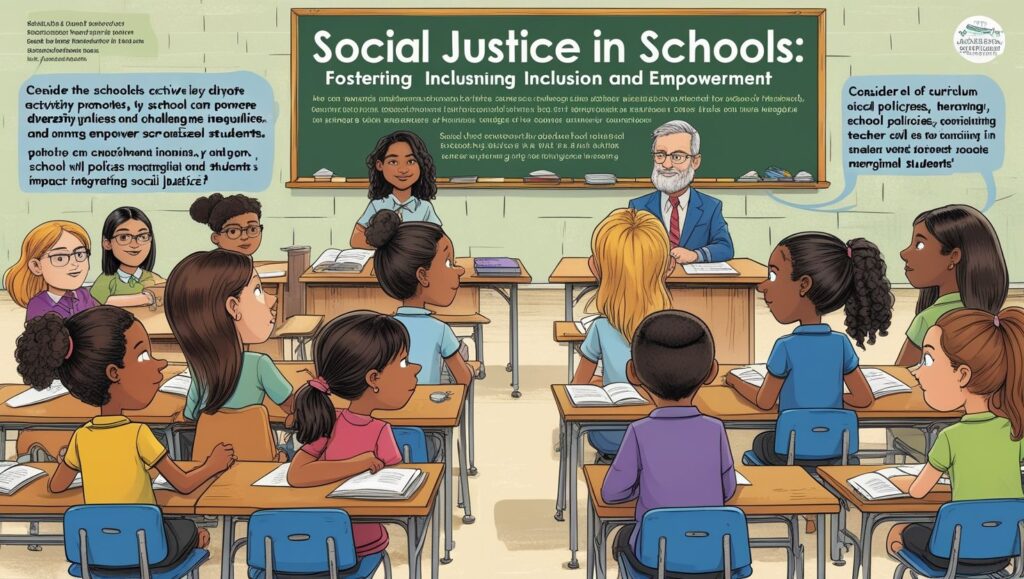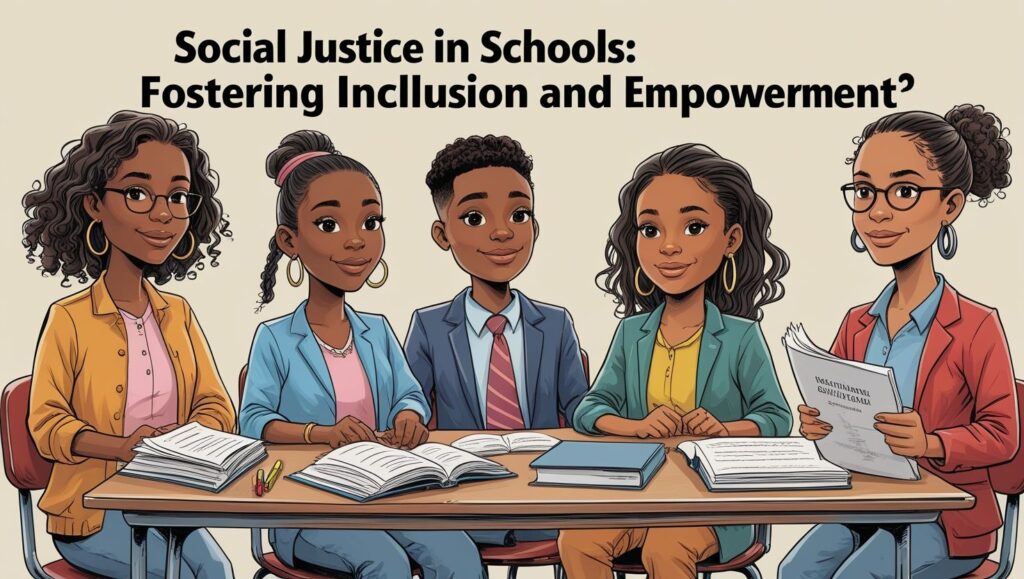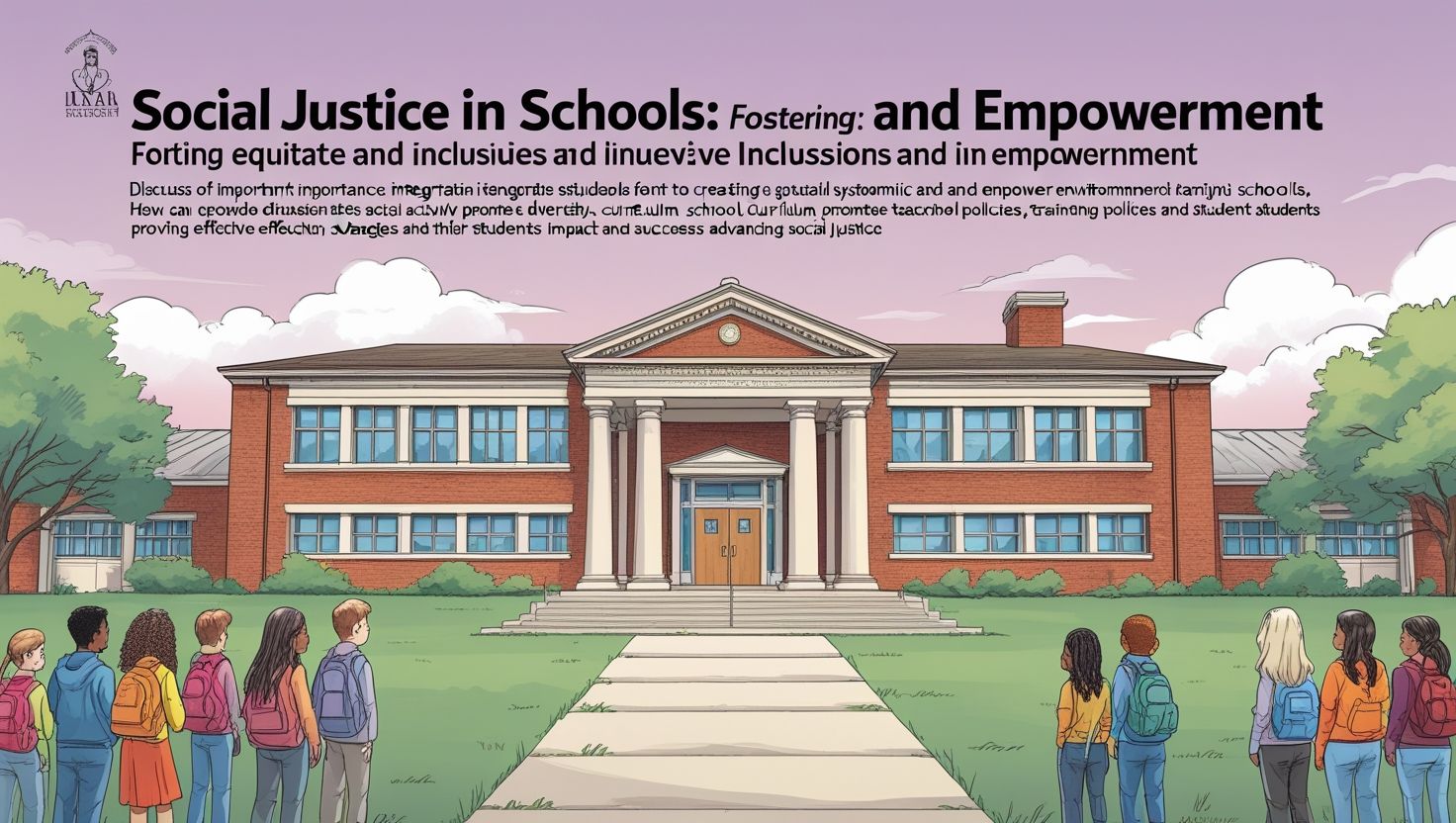Introduction
Social Justice in Schools for Inclusion and Empowerment, Social justice in education extends far beyond academic achievement; it involves creating an inclusive and equitable learning environment where all students, regardless of their background, have equal opportunities to succeed. Schools play a pivotal role in either perpetuating or dismantling systemic inequalities. By integrating social justice principles into policies, practices, and curricula, educational institutions can become powerful catalysts for societal transformation (Sensoy & DiAngelo, 2017). This essay explores the significance of embedding social justice in schools, examining strategies to promote equity, diversity, and inclusion while highlighting the long-term benefits for students and society.
Understanding Social Justice in Education
Social justice in education is the commitment to fairness, equity, and inclusion in all aspects of schooling, from classroom instruction to institutional policies. It requires recognizing and addressing systemic barriers that disproportionately affect marginalized groups, including students of color, low-income students, LGBTQ+ youth, students with disabilities, and English language learners (Gorski, 2013). The goal is to dismantle oppressive structures, challenge biases, and empower students to become agents of change in a diverse and unequal world (Freire, 1970).
Key dimensions of social justice in education include:
- Equity in Access – Ensuring all students receive the resources and support they need to thrive.
- Inclusive Pedagogy – Incorporating diverse perspectives and culturally responsive teaching methods.
- Critical Consciousness – Encouraging students to analyze power structures, privilege, and oppression (hooks, 1994).
- Advocacy & Activism – Empowering students to engage in social change through civic participation.

Strategies for Promoting Social Justice in Schools
1. Cultivating an Inclusive School Culture
A school’s culture sets the foundation for equity and belonging. Strategies include:
- Celebrating Diversity – Hosting cultural events, heritage months, and inclusive assemblies to honor students’ identities (Banks, 2016).
- Anti-Bias Training – Providing professional development for educators on implicit bias, microaggressions, and culturally sustaining pedagogy (Ladson-Billings, 2014).
- Inclusive Policies – Implementing gender-neutral restrooms, anti-bullying programs, and accommodations for students with disabilities (Artiles et al., 2011).
2. Integrating Social Justice into the Curriculum
A socially just curriculum reflects diverse histories, voices, and experiences. Approaches include:
- Diverse Literature & Media – Incorporating books and materials by authors from marginalized communities (Bishop, 1990).
- Critical Historical Analysis – Teaching history from multiple perspectives, including the impact of colonization, slavery, and systemic racism (Loewen, 2007).
- Intersectional Discussions – Encouraging dialogue on race, class, gender, and sexuality to foster critical thinking (Crenshaw, 1989).
3. Addressing Equity in Access and Opportunity
Systemic barriers often limit students’ success. Schools can promote equity by:
- Resource Allocation – Ensuring underfunded schools receive adequate funding, technology, and materials (Darling-Hammond, 2010).
- Targeted Support Programs – Providing tutoring, mentorship, and college readiness initiatives for marginalized students (Howard, 2010).
- Restorative Justice Practices – Replacing punitive discipline with conflict resolution and peer mediation (Zehr, 2002).

4. Promoting Civic Engagement and Student Activism
Empowering students to advocate for change fosters leadership and social responsibility. Strategies include:
- Service-Learning Projects – Connecting classroom learning to community activism (Westheimer & Kahne, 2004).
- Youth-Led Advocacy – Supporting student protests, petitions, and awareness campaigns on issues like climate justice and racial equity (Ginwright, 2010).
- Democratic Participation – Encouraging student government involvement and participatory budgeting (Mitra, 2018).
5. Building Community Partnerships
Collaboration with families and organizations strengthens social justice efforts. Approaches include:
- Parent & Community Engagement – Hosting workshops on equity and involving families in decision-making (Epstein, 2018).
- Partnerships with Advocacy Groups – Working with nonprofits to provide mental health services, food security, and legal support for disadvantaged students (Warren & Mapp, 2011).
Benefits of Social Justice in Schools
Research shows that socially just education leads to:
✅ Higher Academic Achievement – Marginalized students perform better in inclusive environments (Nieto, 2010).
✅ Stronger Social-Emotional Skills – Students develop empathy, resilience, and conflict-resolution abilities (CASEL, 2020).
✅ Greater Civic Engagement – Youth are more likely to vote, volunteer, and advocate for justice (Flanagan et al., 2007).
✅ Reduced Prejudice – Exposure to diverse perspectives decreases stereotypes (Allport, 1954).
Conclusion
Social justice in education is not optional—it is a moral imperative. By fostering inclusive cultures, equitable policies, and critical curricula, schools can dismantle systemic oppression and empower students to create a fairer world. Educators must commit to ongoing learning, advocacy, and collaboration to ensure every student thrives. As Paulo Freire (1970) asserted, education should liberate, not oppress. Prioritizing social justice in schools is the first step toward a more just society.

References
Sensoy, Ö., & DiAngelo, R. (2017). Is Everyone Really Equal?
Allport, G. (1954). The Nature of Prejudice.
Banks, J. (2016). Cultural Diversity and Education.
Bishop, R. S. (1990). “Mirrors, Windows, and Sliding Glass Doors.”
Crenshaw, K. (1989). “Demarginalizing the Intersection of Race and Sex.”
Freire, P. (1970). Pedagogy of the Oppressed.
Gorski, P. (2013). Reaching and Teaching Students in Poverty.
Ladson-Billings, G. (2014). Culturally Relevant Pedagogy.

Thank you for your sharing. I am worried that I lack creative ideas. It is your article that makes me full of hope. Thank you. But, I have a question, can you help me?
Thank you for your sharing. I am worried that I lack creative ideas. It is your article that makes me full of hope. Thank you. But, I have a question, can you help me?
Your article helped me a lot, is there any more related content? Thanks!
Thanks for sharing. I read many of your blog posts, cool, your blog is very good.
Can you be more specific about the content of your article? After reading it, I still have some doubts. Hope you can help me.
Can you be more specific about the content of your article? After reading it, I still have some doubts. Hope you can help me.
Your article helped me a lot, is there any more related content? Thanks!
k1ms7d
i3uchi
Hiya, I am really glad I’ve found this information. Nowadays bloggers publish just about gossips and net and this is actually irritating. A good site with exciting content, this is what I need. Thank you for keeping this web site, I’ll be visiting it. Do you do newsletters? Cant find it.
akpx41
Your point of view caught my eye and was very interesting. Thanks. I have a question for you.
Very interesting information!Perfect just what I was searching for!
Thank you, your article surprised me, there is such an excellent point of view. Thank you for sharing, I learned a lot.
I love your writing style genuinely enjoying this website .
I don’t think the title of your article matches the content lol. Just kidding, mainly because I had some doubts after reading the article.
Wonderful website. Plenty of helpful information here. I’m sending it to a few buddies ans also sharing in delicious. And obviously, thank you in your effort!
Great post. I am facing a couple of these problems.
https://t.me/s/Official_1win_kanal/1293
Официальный Telegram канал 1win Casinо. Казинo и ставки от 1вин. Фриспины, актуальное зеркало официального сайта 1 win. Регистрируйся в ван вин, соверши вход в один вин, получай бонус используя промокод и начните играть на реальные деньги.
https://t.me/s/Official_1win_kanal/1371
Some genuinely good info , Gladiola I detected this. “We protest against unjust criticism, but we accept unearned applause.” by Jose Narosky.
I like this website so much, bookmarked. “To hold a pen is to be at war.” by Francois Marie Arouet Voltaire.
I know this if off topic but I’m looking into starting my own blog and was curious what all is required to get setup? I’m assuming having a blog like yours would cost a pretty penny? I’m not very web smart so I’m not 100 certain. Any recommendations or advice would be greatly appreciated. Kudos
Hello. excellent job. I did not anticipate this. This is a splendid story. Thanks!
You made certain nice points there. I did a search on the matter and found the majority of people will go along with with your blog.
I really enjoy reading on this site, it contains superb blog posts.
Your point of view caught my eye and was very interesting. Thanks. I have a question for you.
Your article helped me a lot, is there any more related content? Thanks!
Thank you for your sharing. I am worried that I lack creative ideas. It is your article that makes me full of hope. Thank you. But, I have a question, can you help me? https://www.binance.info/vi/register?ref=WTOZ531Y
Amazing blog! Is your theme custom made or did you download it from somewhere? A design like yours with a few simple tweeks would really make my blog stand out. Please let me know where you got your theme. Bless you
Excellent site. Plenty of helpful info here. I’m sending it to a few pals ans also sharing in delicious. And naturally, thanks in your effort!